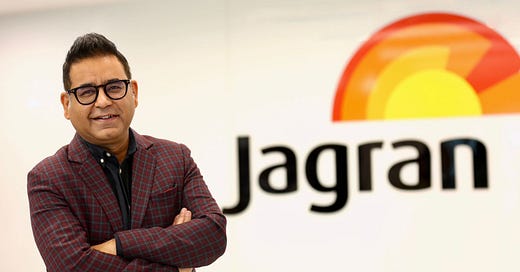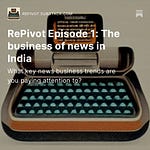This episode of RePivot features a conversation between Gaurav Arora, Chief Operating Officer at Jagran New Media and Ramanathan S, a media consultant and RePivot member. Rohan Venkat plays host, probing our guests on the topics of digital advertising and the journey of a regional publisher to try and attain financial sustainability in the digital realm. Gaurav has nearly 24 years of professional experience, of which nearly 20 years have been in digital publishing. He has focused on generating revenues from the online ventures of traditional news companies (Jagran and Times Internet). Through this podcast we hope you get:
A good understanding of how digital advertising works in (and perhaps for) news media — display ads, programmatic ads, ad networks, native ads, branded content and other formats that have evolved.
Digital advertising’s track record so far and its impact on newsrooms. Has it affected the quality of journalism?
Jagran’s experiments in the space — what does a news company need to learn do to generate revenue? Models that we discuss: Advertising (direct or programmatic), reader revenue, syndication (or partnerships), and the brand studio.
The future of digital advertising and what media professionals could look out for: third party cookies, first party data and unlimited digital advertising inventory.
The Jagran Group
The Dainik Jagran group, also known as Jagran Prakashan, is among the top news media companies in terms of audiences reached in India. It is 81 years-old and has diversified interests in newspapers, magazines, radio, outdoor advertising and events with a market capitalisation of INR 2,200 Crore at the time of this writing. Jagran New Media is the digital publishing arm of the group.
Even though it is publicly listed on India’s leading exchanges, 70% is owned by the promoter family — the Guptas of Kanpur — who are hands on in running the business. Dainik Jagran, the group’s flagship Hindi daily, had nearly 17 million in average issue readership* as per the Indian Readership Survey 2019 Q4 (the last available IRS), the highest readership for a newspaper in any language in India. Dainik Jagran showed a daily circulation of 1.27 million copies as per the audit bureau of circulation’s July-Dec 2022 results, making it India’s fourth largest circulated newspaper in Hindi. Its main competitors are Dainik Bhaskar (3.56 million) Amar Ujala (1.74 million) and Hindustan (1.64 million).
Jagran also owns print brands such as Mid-Day (English), Mid-Day Gujarati, Inquilab (Urdu), Nai Dunia (Hindi), Dainik Jagran i-Next (Hindi and English), Sakhi (Hindi) and Punjabi Jagran, which together contributed 13% of group revenue. It owns 39 FM radio stations under the Radio City brand (11% revenue).
The company claimed its print circulation is back at 90% of pre-Covid levels in its FY23 results released in May 2023. Its operating revenues have recovered to nearly 80% of pre-Covid levels — INR 1,856 crore for FY23 v. INR 2,363 crore for FY19 — seeing a corresponding change in its share price (see images).


Jagran.com, Jagran New Media’s main digital platform, registered about 84 million unique visitors per month as per Comscore in April 2023. Combined with its other digital sites and apps, its monthly digital reach is above 100 million, according to Gaurav Arora. Social media reach across platforms is about 432 million users (not unique). Its annual operating revenue for its digital publishing activity was INR 86 Crore for FY23, with a 9.5% operating profit. Overall group digital revenues, which includes digital radio and a few more operations, crossed INR 100 Cr according to the company. Operating revenue for the last quarter of FY23 (Jan-Mar) ended 20 percentage points higher than the same period last year, indicating that India’s consumer economy bounced back healthily after the pandemic years, leading to better rates and yields in digital advertising.
Gaurav shared that Jagran New Media makes half its revenue through direct ad sales (which includes the contribution of their brand studio), about 30% from programmatic sales (via ad networks such as Google) and about 20% from syndications and reader revenue (subscriptions). A robust war chest of over INR 1000 crores in cash reserves, Jagran will be a media group to watch out for in the digital publishing 2.0 era.
“Digital advertising is estimated to grow from FY23 to FY24 to about INR 40,000 crores of absolute revenue. So out of that pie of forty thousand crores, the top 15 publishers (as per Comscore under the news and publisher category) are estimated to make about INR 2000 odd crores. So the volume of money to start with is not very huge here.”
- Gaurav Arora on why news publishers need diversity in their revenue stream.
Listen in for more insights on what the future of digital advertising means for journalism and the news media industry. And do share your thoughts in the comments or directly with us at repivot.substack.com.














Share this post